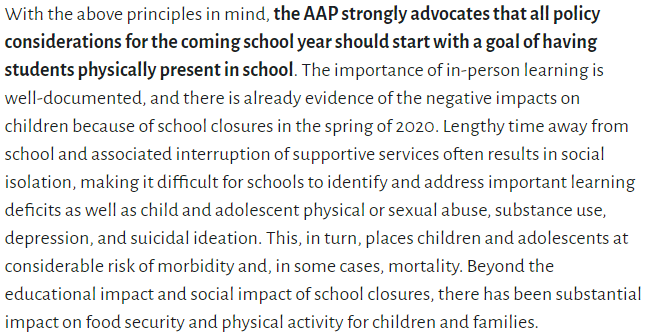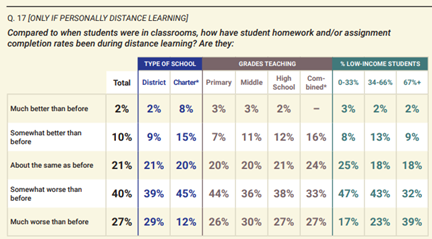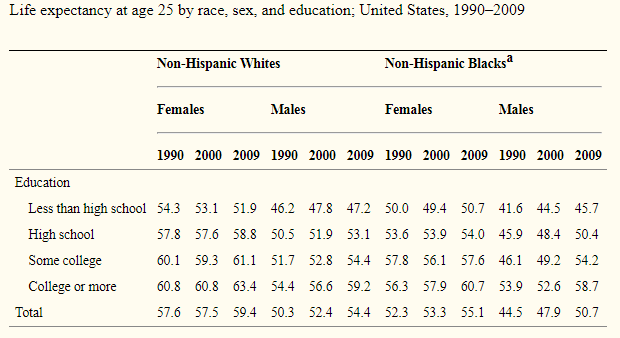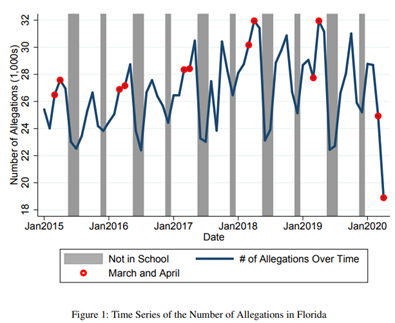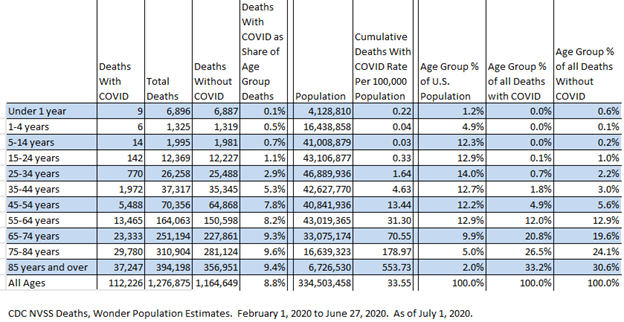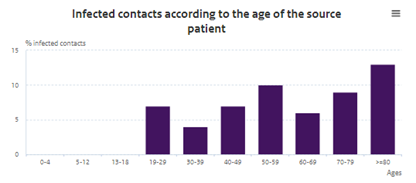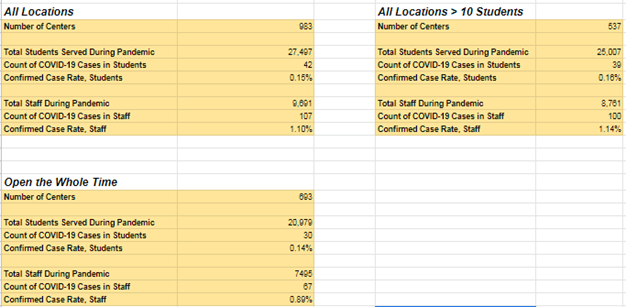It is not safe to keep schools closed.
Summary from the American Academy of Pediatrics, the principal medical society for 67,000 pediatricians.
https://services.aap.org/en/pages/2019-novel-coronavirus-covid-19-infections/clinical-guidance/covid-19-planning-considerations-return-to-in-person-education-in-schools/">https://services.aap.org/en/pages/...
https://services.aap.org/en/pages/2019-novel-coronavirus-covid-19-infections/clinical-guidance/covid-19-planning-considerations-return-to-in-person-education-in-schools/">https://services.aap.org/en/pages/...
According to an EdChoice/Morning Consult poll, the number one concern parents presently have about education is missing instruction time. This is a concern of 80 percent of parents.
And they have good reason to be concerned. A large "COVID slide" is appearing that dwarfs the normal summer slide, and it is most severe for less advantages groups, exacerbating societal inequalities.
"Preliminary research suggests students nationwide will return to school in the fall with roughly 70% of learning gains in reading relative to a typical school year, and less than 50% in math, according to projections by NWEA" https://www.wsj.com/articles/schools-coronavirus-remote-learning-lockdown-tech-11591375078">https://www.wsj.com/articles/...
Many students tuned out completely: "Early into the shutdown, the Los Angeles Unified School District estimated that on any given day in a week span, 32% of high-school students didn’t log in to learn."
A national teacher survey by Educators 4 Excellence found that 67% of teacher said student assignment completion rates dropped when they ended in-classroom instruction.
https://e4e.org/sites/default/files/voices_from_the_virtual_classroom_2020.pdf">https://e4e.org/sites/def...
https://e4e.org/sites/default/files/voices_from_the_virtual_classroom_2020.pdf">https://e4e.org/sites/def...
And we know special needs students are hurt the worst. Teletherapies are not the same, and have not proven effective for many students who have special learning needs.
We cannot morally undermine the quality of our children& #39;s education over a public health concern that, for children, carries less risk than the seasonal flu.
The relationship between educational attainment and life expectancy is strong and getting stronger.
As this table from a recent study supported by the National Institute on Aging and the National Institute of Child Health and Human Development found, life expectancy at age 25 is four to six years longer for a high school graduate than a dropout.
https://www.ncbi.nlm.nih.gov/pmc/articles/PMC5482278/">https://www.ncbi.nlm.nih.gov/pmc/artic...
https://www.ncbi.nlm.nih.gov/pmc/articles/PMC5482278/">https://www.ncbi.nlm.nih.gov/pmc/artic...
In addition to the loss of instruction time, full or partial school closures have substantial negative mental health consequences.
Carol Burris, a former teacher and award-winning principal, explains why it is vital that schools find a safe way to open for their most vulnerable students. https://www.washingtonpost.com/education/2020/07/06/why-schools-must-find-safe-way-reopen-most-vulnerable-students-by-veteran-educator/">https://www.washingtonpost.com/education...
"Combating truancy, school phobia, student depression, and drug dependency were part of our everyday work. The tragedy of student suicide was not unknown to us.
"Some students needed help talking to parents about their pregnancy or support in leaving an abusive relationship. And then there were the students living with parents who themselves were unwell.
"Students at risk can easily slip through cracks. Due to the isolation of remote learning, those cracks have become crevices.
"Anecdotally, pediatricians are reporting rises in depression, obesity, and stress disorders as well as young children having heart palpitations absent a physical cause.
"Research tells us that socially isolated children and adolescents are at risk of depression and anxiety. We know that too much screen time can result in inattention and impulsivity, and mental health disorders in both children and adolescents."
Even a one percent increase in the suicide rate among high school students would cause more deaths than have died with COVID-19 so far in that age group.
And tragically, less time in school means a greater chance that our most vulnerable children, victims of abuse, will not receive the help they need.
“Teachers and school personnel comprise one of the largest groups to report child abuse... On average, we are seeing an over 25 percent decrease in calls to our hotline since schools closed. That means many children are suffering in silence.”
— Arizona Department of Child Safety
— Arizona Department of Child Safety
Researchers from the University of Michigan and Florida State University found that in March and April alone, an estimated 212,500 allegations of child abuse went unreported because of school closures. https://papers.ssrn.com/sol3/papers.cfm?abstract_id=3601399">https://papers.ssrn.com/sol3/pape...
While keeping schools closed is manifestly unsafe, opening them is not.
"For children (0-17 years), cumulative COVID-19 hospitalization rates are much lower than cumulative influenza hospitalization rates at comparable time points during recent influenza seasons."
--CDC COVIDView, same language every week
--CDC COVIDView, same language every week
"There have been based on the data so far extremely low risk to children... It is an unbelievably low risk. This group of kids are staggering safe in general...
... Nobody has ever been safer in the history of humanity than these kids."
-- Sir David Spiegelhalter, Chair of the Winton Centre for Risk and Evidence Communication, Cambridge
-- Sir David Spiegelhalter, Chair of the Winton Centre for Risk and Evidence Communication, Cambridge
Children are at far lower risk of hospitalization or death with COVID than they are with lab-confirmed influenza, a risk we accept without any extraordinary measures.
Therefore if any modifications of school operations are justified based on risks to children, they should logically have been made historically and should be permanent.
It is immoral deny children education and social interaction on account of a disease which does not present a significant risk to them.
Children are Not a Significant Source of Community Transmission
Iceland: "Children under 10 are less likely to get infected than adults and if they get infected, they are less likely to get seriously ill...
What is interesting is that even if children do get infected, they are less likely to transmit the disease to others than adults. We have not found a single instance of a child infecting parents." https://www.sciencemuseumgroup.org.uk/hunting-down-covid-19/">https://www.sciencemuseumgroup.org.uk/hunting-d...
Switzerland found: “Even when children are tested positive for the virus, their viral load is often very low. Which would explain why they are bad vectors of the disease. It seems that it is adults who infect children, not the other way around.” https://www.rts.ch/info/sciences-tech/medecine/11255942-en-suisse-104-enfants-de-moins-de-10-ans-ont-ete-testes-positifs-au-covid-19.html">https://www.rts.ch/info/scie...
https://twitter.com/BallouxFrancois/status/1277933547400167424">https://twitter.com/BallouxFr...
Netherlands: "Data from the Netherlands also confirms the current understanding: that children play a minor role in the spread of the novel coronavirus. The virus is mainly spread between adults and from adult family members to children." https://www.rivm.nl/en/novel-coronavirus-covid-19/children-and-covid-19">https://www.rivm.nl/en/novel-...
"COVID-19 is primarily spread between people who are about the same age. The figure below shows data on 693 paired patients, displaying the ages of both the source patient and the patient that they infected."
France: Risk for children is “extremely low, we can say a thousand times lower than in adults. Children are weak carriers, poor transmitters, and when they are infected it is almost always adults in the family who have infected them."
https://translate.google.com/translate?sl=fr&tl=en&u=https%3A%2F%2Fwww.bfmtv.com%2Fsante%2Fpeuporteurs-peu-transmetteurs-une-etude-confirme-le-role-minime-des-enfants-dans-l-epidemie-de-covid-19-1912853.html">https://translate.google.com/translate...
https://translate.google.com/translate?sl=fr&tl=en&u=https%3A%2F%2Fwww.bfmtv.com%2Fsante%2Fpeuporteurs-peu-transmetteurs-une-etude-confirme-le-role-minime-des-enfants-dans-l-epidemie-de-covid-19-1912853.html">https://translate.google.com/translate...
Australia: "When school closures were initially proposed to control an epidemic, planners had influenza in mind. Flu spreading within schools and children are the main source for transmission in the community. But COVID-19 is not the flu.
"Far fewer children are affected by COVID-19, and the number of transmissions from children to children and children to adults is far less." https://www.health.gov.au/news/getting-our-kids-back-to-school-a-matter-of-trust">https://www.health.gov.au/news/gett...
A recent WSJ news article summarized the experience across the world:
"Denmark, Austria, Norway, Finland, Singapore, Australia, New Zealand and most other countries that have reopened classrooms haven’t had outbreaks in schools or day-care centers." https://www.wsj.com/articles/is-it-safe-to-reopen-schools-these-countries-say-yes-11590928949">https://www.wsj.com/articles/...
"Denmark, Austria, Norway, Finland, Singapore, Australia, New Zealand and most other countries that have reopened classrooms haven’t had outbreaks in schools or day-care centers." https://www.wsj.com/articles/is-it-safe-to-reopen-schools-these-countries-say-yes-11590928949">https://www.wsj.com/articles/...
The one German study by Christian Drosten that tried to justify school closures by claiming children did not have lower viral loads arbitrarily binned age, a continuous variable, and still failed to support its predetermined conclusion.
Drosten& #39;s junk science was emphatically rejected in a joint statement from all of the leading German medical societies:
In their statement, the German medical societies say: "Day care centers, kindergartens and primary schools should be reopened as soon as possible," and "unrestricted." https://www.spiegel.de/panorama/bildung/corona-krise-mediziner-fordern-komplette-schul-und-kita-oeffnung-a-4d1a0336-680d-4259-818e-7a263732f811">https://www.spiegel.de/panorama/...
We also have preliminary evidence from the United States that lines up with the rest of the world.
We see no significant disease burden among children who have remained in childcare throughout the epidemic, despite the fact that as children of essential workers they are more likely to be exposed at home.
A large convenience sample collected by Dr. Emily Oster of Brown University found a confirmed case rate among all reporting childcare centers of just 0.15%.
#gid=204576280">https://docs.google.com/spreadsheets/d/1L45r63t8hpYfGLpT6gWKjYMscu8Wut6jtlxO-1FAW9c/edit #gid=204576280">https://docs.google.com/spreadshe...
#gid=204576280">https://docs.google.com/spreadsheets/d/1L45r63t8hpYfGLpT6gWKjYMscu8Wut6jtlxO-1FAW9c/edit #gid=204576280">https://docs.google.com/spreadshe...
Finally, EVEN IF, contrary to available evidence, children are a significant source of spread, a rigid 6-foot rule is the worst possible policy.
Put simply, a rigid 6 foot rule means millions of children will be in school only part-time, which means many of them will have other childcare arrangements on the days they are not in school –
dramatically *increasing* overall population mixing relative to the alternative of them being consistently with the same group of children in school.
The balance of evidence is clear. Children must not be denied full-time classroom instruction.

 Read on Twitter
Read on Twitter